Metropolitan Fiber And Smart Cities
Fiber is essential to supporting the development of "Smart Cities."
Defining a Smart City is not easy as it is broad in scope and requires
forecasting the development of new technologies. Also
few of those involved in the various aspects of what makes up a Smart City
have the same view of what it means as they see it from only their point of
view.
Generally a "Smart City" is one that uses information and
communications technology to manage the entirety of the city with the goal of
making it more efficient, responsive, and environmentally sensitive, etc. for
the benefit of the people, the economy and the city itself.
Let's list some of the services involved in a Smart City.
Communications - Communications is the central focus of smart cities -
communications among city departments and organizations, within the city for
residents and visitors and links to the outside world via data (Internet),
voice (landline and cellular) and video entertainment (CATV and OTT). A
proper communications infrastructure will require a city-wide high speed
fiber backbone with sufficiently fast connections to the worldwide Internet
backbone that neither capacity nor speed is an issue. The fiber backbone
provides the connectivity for all the options listed below as well as fiber
for citywide ISP connections to the businesses and residents.
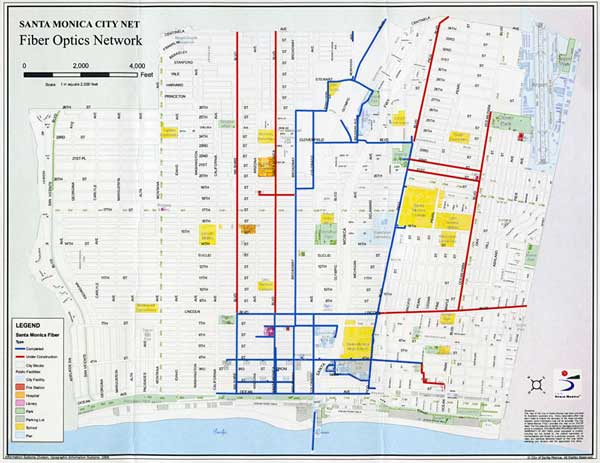
Santa Monica, CA CityNet fiber optic backbone
Progressive cities like Santa Monica, CA have built their own city backbones
that provides for city-wide communications for all the city's uses and then provides
fiber and or connectivity to other service providers and businesses in the
city. The Santa Monica CityNet backbone, for example, also serves FiOS FTTH
customers and Spectrum CATV networks. In addition it
connects many businesses, large and small, with up to 100Mb/s service.
In an urban area, fiber to the home (FTTH) and business is expected, although
some alternative services like future generations of wireless may provide
adequate capacity. Outside the urban center, fiber backbones may be used with
wireless or DSL to connect users if adequate bandwidth can be provided.
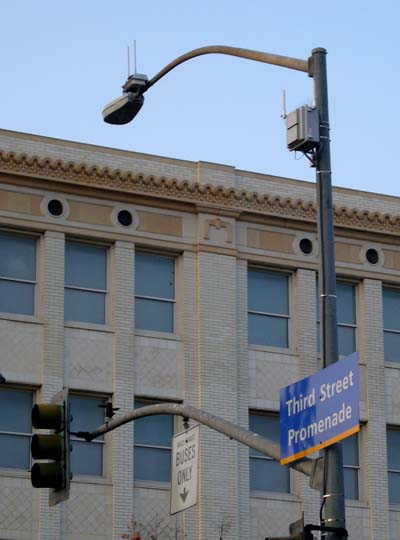
Santa Monica has two separate WiFi systems, public and private for public
safety use only
The fiber backbone provides connections for multiple wireless service
providers, both cellular and WiFi, to ensure a competitive marketplace. With
the advent of small cells, any utility pole, street light
or traffic light can provide quality wireless services without the unsightly
cell towers or sites that urban dwellers dislike, even as they want state of
the art wireless communications. Enough fiber and backbone capacity is needed to provide DAS (distributed antenna systems)
services to large buildings both private and public, college campuses and
sports facilities.
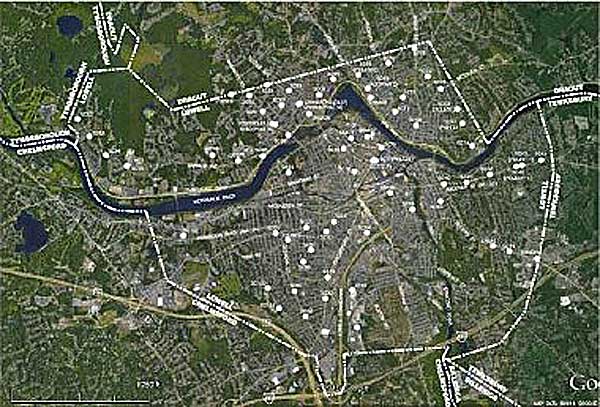
Verizon map of proposed small cells in Lowell, MA
That same backbone also allows Internet service and CATV over a hybrid fiber
coax (HFC) network, preferably with multiple competitive services. Having
high speed Internet to all citizens allows the choice of conventional CATV
services or Internet based viewing packages which are gaining in popularity.
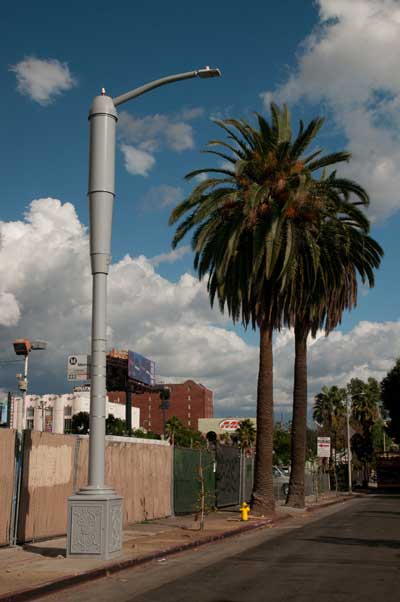
The city of Los Angeles is installing these smart street lights - LED
lighting with small cell wireless antennas hidden in the wide section of the
light pole near the top. Small cells allow cities to have good cellular
service without unsightly cell towers.
City Services - information about the city and city services for the
citizens should be online and accessible. All relevant services should be
able to be done online rather than in person.
Transportation and Traffic management - smart traffic signals, video
and radar monitoring of traffic, parking and creating a vehicle-to-vehicle
and vehicle-to-infrastructure communications environment that will facilitate
autonomous traffic in the future. Public transportation is fully managed,
online information and booking provided, wireless available to riders.
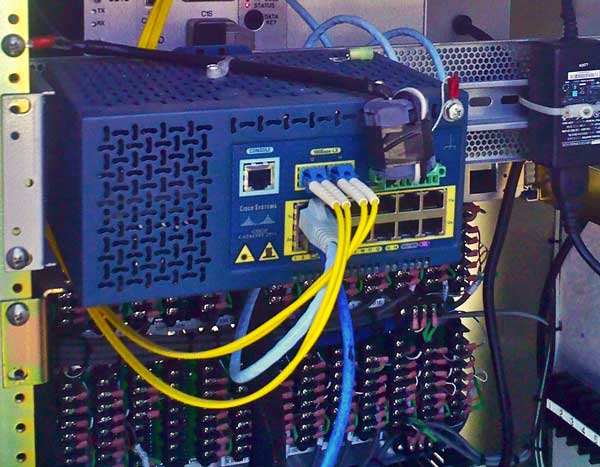
Smart traffic controls on fiber backbone
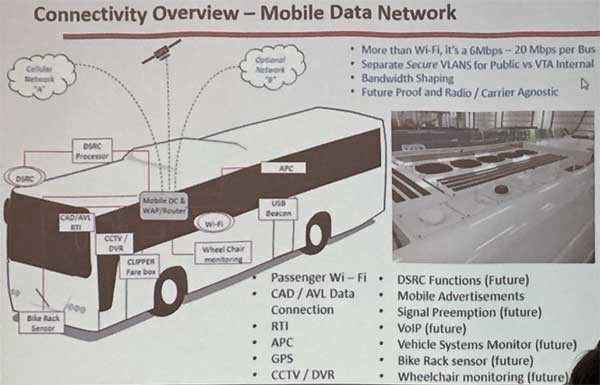
Connected busses at Santa Clara Valley Transportation Authority (SCVTA) offer
wireless to riders and tracking vehicle locations
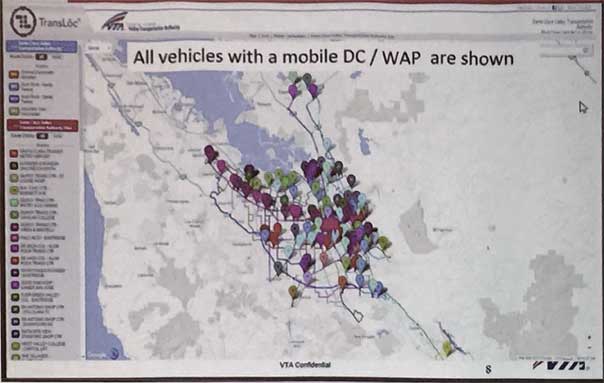
Real time location of SCVTA busses, trains and other vehicles
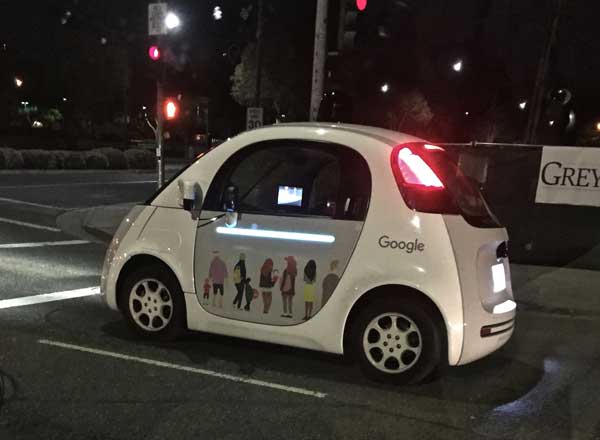
Google prototype on the streets of Mountain View, CA near Google headquarters
Autonomous vehicles like this will certainly have lots of onboard sensors and
information processing to drive on the streets with regular cars. But
engineers involved in developing cities of the future seem to believe that
having cars talk to each other and with numerous city services - smart
traffic signals, traffic signs, information from video surveillance as to the
location of other vehicles, pedestrians, bicyclists, etc. will simplify the
task of the vehicle itself and make it operation safer.
Public Safety Communications - using communications to make the
public safety divisions -fire, police, ambulance, etc. - more responsive and
more responsible. This includes wireless communications on reserved
frequencies and perhaps a dedicated WiFi network throughout the city and, if
there are high-rise buildings that limit penetration of wireless, it may
require DAS, distributed antenna systems, inside the buildings.
Surveillance And Sensors - traditionally
video surveillance has been the focus of city-wide surveillance. These videos
have been instrumental at preventing and solving crimes in many cities by
identifying people. New types of sensors are being deployed, including
gunshot sensors that can detect gunshots and locate the source using
sophisticated audio techniques.
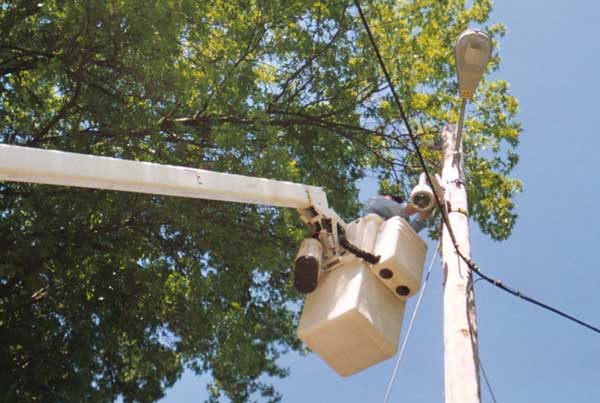
Installing video surveillance cameras on a street light
in St. Louis, MO
Now the usefulness of those cameras can be extended to tracking traffic for
smart vehicles and helping control the movement of traffic. As semi- and
fully autonomous vehicles begin using public streets, car-to-car and
car-to-city communications are expected to be needed to facilitate this
transition.
Education - connect schools, libraries, and the citizens to share
information and optimize the educational experience for all. Students learn
to use the Internet in ways that facilitate their work in high-tech companies
in the future.
Public Services - allowing monitoring and control of public utilities
- electrical (generation and distribution as well as renewable), water,
sewer, gas, etc. - to make them more efficient and economical. The electrical
"smart grid" is becoming smarter, integrating alternative energy
sources with traditional electrical generation and distribution. With cities
that have many business and private solar system for example, integrating
those sources and smoothing out the use of electricity is leading many to
assume that local storage, batteries usually, can be used to store excess
energy during the day for use at night. Managing these kinds of facilities
requires sophisticated grid management, often down to the local level -
called micro-grids -
Support For Business - The economy of a city
depends on a healthy, expanding business base. This goes beyond just
providing high speed Internet to businesses, it means offering really high bandwidth services to data-centric businesses
and even data centers located in the city. Cities should have plans for tech
incubators and services to support and facilitate new businesses locating
there.
The Internet Of Things - IoT is an overused
and little understood term that seems to imply that all sorts of things
communicate over the internet creating a communications environment that
facilitates the development of logical connections for improving the quality
and economics of services. It implies that Internet connections, wireless and
landline, is everywhere and cheap enough to allow connecting all sorts of
devices.
Smart Economy - all of the above contribute to an environment where
both the citizens and local companies will find opportunities for developing
new ideas that benefit from the Smart City services and facilitates
entrepreneurship and operation of commercial entities.
Data Centers - a Smart City generates and uses data - lots of data -
to become and stay smart. Doing so requires a significant sized data center
with sufficient storage, computing power and communications to handle the
quantities of data generated, analyzed and
transmitted. Such a data center can be a city facility
or a cloud service hosted in the city. Data centers require really big, fast Internet connections, usually with
options for the data center operators to bring in their own backbone
connections.
We include a data center as a required city service because Smart Cities are
built on data. A large city could require a data center approaching the size
of the mega-data centers being used by the large Internet companies or cloud
service providers. Smaller cities of course can use smaller data centers or
cloud service providers. But provision for acquiring, analyzing, utilizing and storing such large amounts of data requires
planning for facilities and the personnel to operate them as well as
sufficient communications services to handle the massive amounts of data
involved.
Partnerships - Smart cities require cooperation. Some of the services
mentioned already exist in many cities but often are owned and operated by
different entities. Duplicating resources is costly so sharing of resources,
especially backbone fiber, is recommended, with appropriate compensation,
whenever possible. For instance, a single street light can provide lighting,
video and/or radar for surveillance and traffic management, WiFi for private
and public use including vehicle communications, locations for small cell
telecommunications, weather and pollution monitoring and other yet unforeseen
services.
Smart Cities Are Built On Fiber
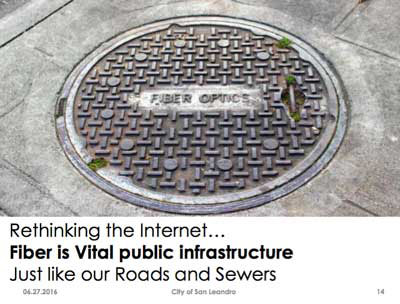
Slide
from a presentation by the city of San Leandro, CA
As
with all state-of-the-art communications, Smart Cities are built on fiber
optic backbones. But fiber alone is not enough. It is necessary to use the
fiber to connect other services like wireless, both cellular and WiFi, video,
CATV and OTT on the Internet, and a large number of
devices and networks that are used to monitor and control all the
"things" that are capable of contributing to the Smart City only
when they are able to communicate and be controlled through a central
facility.
More on the
applications of fiber optics.
